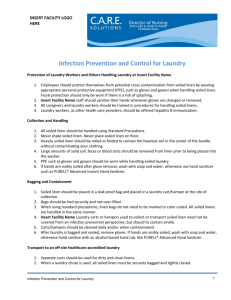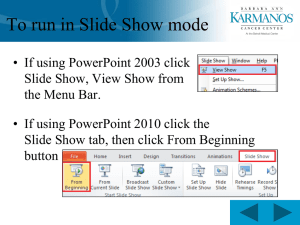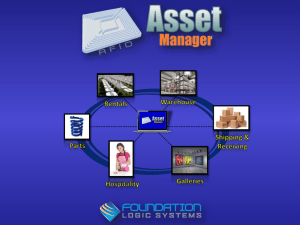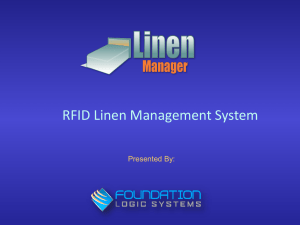Further Information General instructions - collect soiled linen
advertisement
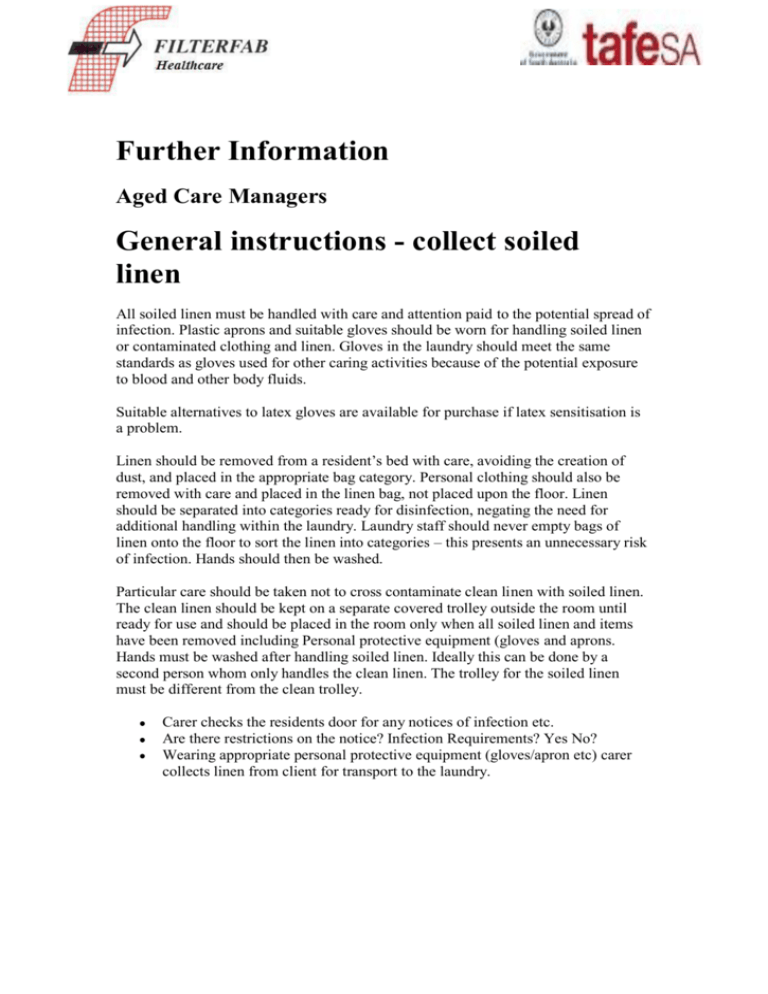
Further Information Aged Care Managers General instructions - collect soiled linen All soiled linen must be handled with care and attention paid to the potential spread of infection. Plastic aprons and suitable gloves should be worn for handling soiled linen or contaminated clothing and linen. Gloves in the laundry should meet the same standards as gloves used for other caring activities because of the potential exposure to blood and other body fluids. Suitable alternatives to latex gloves are available for purchase if latex sensitisation is a problem. Linen should be removed from a resident’s bed with care, avoiding the creation of dust, and placed in the appropriate bag category. Personal clothing should also be removed with care and placed in the linen bag, not placed upon the floor. Linen should be separated into categories ready for disinfection, negating the need for additional handling within the laundry. Laundry staff should never empty bags of linen onto the floor to sort the linen into categories – this presents an unnecessary risk of infection. Hands should then be washed. Particular care should be taken not to cross contaminate clean linen with soiled linen. The clean linen should be kept on a separate covered trolley outside the room until ready for use and should be placed in the room only when all soiled linen and items have been removed including Personal protective equipment (gloves and aprons. Hands must be washed after handling soiled linen. Ideally this can be done by a second person whom only handles the clean linen. The trolley for the soiled linen must be different from the clean trolley. Carer checks the residents door for any notices of infection etc. Are there restrictions on the notice? Infection Requirements? Yes No? Wearing appropriate personal protective equipment (gloves/apron etc) carer collects linen from client for transport to the laundry. Are there restrictions on the notice? Yes / No Infection Requirements as below NO YES Minimal Personal Protective Full Personal Protective Equipment Equipment Required – Eg: Gloves Required – Eg: Gloves, Gown, Face & Apron mask, Socks. Hairnet Position laundry trolley in allocated location Follow Procedures for Infection Control Soiled items placed in allocated linen bag. Position laundry trolley in allocated location Manual Handling Procedures followed Manual Handling Procedures followed Lifting Bags Do Not overload Bags Moving Trolleys Infectious Linen placed in easy identifiable bags for infection control. EG: Dissolvable Bags , Colour Coded Bags, Clearly Labelled etc No cross infection - Separate trolley used for soiled linen Manual Handling Procedures followed Lifting Bags Do Not overload Bags Moving Trolleys Proceed to the Laundry No cross infection - Separate trolley used for soiled linen No cross infection -Entry to laundry through soiled side Direct Route to the Laundry No cross infection -Entry to laundry through soiled side General Instructions - Receive and Sort Soiled Linen Linen is received in the soiled storage area, a cool area for soiled linen is recommended. A laundry area designated for that purpose only, with separate ventilation and a flow through system, so that soiled laundry can arrive through one door and be quickly disinfected, before drying and removal through a separate exit to a clean storage area. Separate Trolleys must be used for soiled linen. Soiled Linen must never enter Clean Area Soiled linen must never enter the clean section of a laundry neither should personnel cross from the clean area to the soiled area without wearing personal protective equipment. In addition personnel should not enter the clean area from the soiled area without removing personal protective equipment and washing their hands. Personal Protective Equipment must be worn and any exposed lesion must be covered with a protective waterproof dressing. Sharps Policy All sites should have a written sharps policy that includes a minimum or appropriate sharps safety containers in accordance with standards shall be located in the soiled handling/sorting areas. Any worker who is injured by a sharp shall follow the in-house sharps policy on documentation, evaluation and follow-up. Colour Coded Infectious Linen is clearly identified by colour/coded or dissolvable bags and shall be processed as soon as possible. Any dry cleaning to be sent off to external dry cleaners, being clearly labeled Laundry staff should never empty bags of linen onto the floor to sort the linen into categories. 4 Main Categories Used linen/soiled Infectious Linen/Foul Heat Liable Linen (fabrics likely to be damaged at thermal disinfection temperatures) Dry Clean only (External Cleaning is identified Eg: Dry Cleaning and stored in allocated area Within these categories darks and lights, fabric types, product types and degree of soil are to be separated. General Instructions – Laundry Processing Clean linen is a fundamental requirement of care. Incorrect handling, laundering and storage of linen can pose a risk of infection. If linen is sent to an off-site laundry, they should be made aware of its nature and their written guidelines should be followed. You should be satisfied that the laundering of items sent will meet decontamination guidelines. Laundering of staff uniforms The uniforms of staff providing personal care should be changed daily, and the wash temperature should reach the minimum of 65°C for at least ten minutes. This should be followed by thorough drying and hot ironing. Important! Under no circumstances should a manual sluice facility or sluicing basin be used or situated in the laundry. Additional Infection Control A documented program for planned, preventive and corrective maintenance of cleaning and laundry equipment and in addition a surveillance program to ensure infection control procedures are followed and incidents are identified for continuous improvement. Supervision of cleaning and laundry practices and regular audit of activity allocation of cleaning equipment to specific areas to eliminate cross contamination Swatch Testing for chemical and micro-organisms Environmental Swab Testing o Trolleys o Benches o Doors General Instructions - Returning Linen to Residents The provision of clean linen is a fundamental requirement of care. Incorrect handling, laundering and storage of linen can pose an infection hazard. It is important that before returning linen to the resident, it has been checked for cleanliness, folded neatly and labelled correctly. Stains, damage, repairs and missing labels are identified and returned to the appropriate area for rework. Items requiring repair or relabelling must be documented and forward to the appropriate area for processing. Once linen has been sorted into the residents names, and quality checked it must be packed neatly onto clean trolley’s and covered with a protective cover, ensuring all the clean linen is covered. The linen may be wrapped in protective covers, bags etc., or placed bundled but unwrapped into clean covered carts or trolleys. The wrapping material may be plastic or other suitable material, and shall be securely closed during transport to the resident. Packaging and storage of linen shall be preserved in a clean state for delivery to the resident. Items of linen must be stored neatly in a clean area, above floor level and not be kept in the laundry area. Summary Clean trolleys only Clean storage only Patient still contaminated – Follow infection control procedures Follow manual handling procedures when; o Making Beds o Turning Mattresses o Lifting Residents o Stacking Linen o Lifting Bags o Moving Trolleys Additional Infection Control Hand washing Environmental Swab Testing Trolleys Benches Care Labels Information How to read care labels What information should a care label give you? According to ASNZS2621-1998, the label should include "appropriate and adequate" instructions for the cleaning and maintenance of an article which, when followed, will not damage the article, including trims. In addition, the label should indicate if any treatment is prohibited or if any special care needs to be taken. We will now look in detail at the Australian Standard for care labeling. What information appears on a care label? As specified in ASNZS2621-1998 a care label must include, where appropriate, adequate instructions from each care category: A. General instructions and warnings B. Washing C. Drying D. Ironing E. Dry cleaning If an item can equally be washed or dry cleaned, then both sets of instructions should appear on the same side of the label. However articles which are not normally dry cleaned, such as underwear or household linen, need only to have instructions for washing. Also drying or ironing instructions can be omitted if no specific or prohibitive instructions are applicable. Symbols - international symbols are to be used in conjunction with written instructions. You may come across a garment with a label written in a foreign language. The table below lists translations of common textile and care terms. Fibre Content English Silk Wool Cotton Rayon Linen Polyester Nylon Ramie Acrylic Acetate Leather French Soie Laine Cotton Rayonne Lin Polyester Nylon Ramie Acrylique Acétate Cuir Spanish Seda Pafio Algodon Rayon Lino Poliester Nylon Ramie Acrilico Acetate Cuero Italian Seta Lana Cotone Rayon Lino Poliestere Nylon Ramie Acrilico Acetato Pelle German Seide Wolle Baumwolle Kunstseide Leinen Polyester Nylon Ramie Acrylic Acetate Leder Care Instructions English Machine Wash Iron Hot Warm Cold Dry Clean French Lavage à la machine Lavage à la main Repassage Eau chaude Eau tiède Eau froide Nettoyage à sec Tumble Dry Séchage rotatif High Très chaud Low Tiède Hand Wash Spanish Lavado a maquina Lavado a mano Italian Lavare in lavatrice Lavare a mano German Maschinenwaesche Handwaschen Planchar Caliente Tibia Fria Lavado en secco Stirare col ferro Acqua calda Acqua tiepida Acqua fredda Lavare a secco Buegeleise Heiss Warm Kalt Chemisch reinigen Trocknen in Trockenautomat Hohe Temperatur Niedrige Temperatur Mittlere Temperatur Bleich Buegeln Dampf Secado a maquina Alto Asciugare in asciugatrice Massimo Medio Baja Medium Chaud Bleach Press Steam Lessive Repassage Vapeur Minimo Mediana Blanquee lejia Planche Vapor Candeggiante Stirare col ferro Stirare a vapore Requirements for specified articles Proper care instructions for particular goods are determined by: the fibre used the fabric construction (eg. closed/open weave, knitted) any trimming, interfacing, lining, decorations, buttons, etc. on the garment the design of the article (eg. cut on the bias) the dyes used (colourfastness) any special treatments applied (eg. waterproofing) the normal care treatment of the article (eg. an article normally washed, such as socks, does not require dry cleaning instructions). Australian Standard AS2621 provides guidance on the selection of care labeling phrases according to the product type and fibre. Table 1 (from AS 2621): Detailed Care Treatment for Textile Products, Accessories and Trims (according to fibre type) Fibre Type Acetate Acrylic Cotton Cuprammonium rayon Down Elastane Elastodine Feathers Flax Glass* Metallic finish fibre Modacrylic Polyamide Polyester Polyester 'Holofil' Polyether foam Polypropylene Polyurethane Protein (regenerated) PVC Silk Soft leather Triacetate Viscose (Rayon) Wool Wool - machine washable Care Treatment Washing Maximum Temperature (oC) 40 40 60 60 40 handwash 60 40 40 handwash 60 40 handwash 40 40 60 60 60 60 40 40 handwash X 60 40 handwash X 40 40 40 handwash 40 Bleaching Ironing Dry cleaning X Cl Cl Cl Cool Cool Hot Warm P P P P X X X X Cl X X Cl X Cl Cl X X X X X X X X Cl X X X Cool Cool X Hot X Cool Warm Cool Warm X X Cool Cool Warm X Warm X Med hot Med hot Warm Warm P P X P P X P P P P X F X P P X P P or F P P P P Drying No machine action Do not tumble Do not tumble Do not tumble Do not tumble Do not tumble Consequences of improper care The consumer has a right to expect that, after treatment according to the care instructions on the label, the article should be clean and still fit for the purpose for which it was intended. That is, no damage should occur to the article if care instructions are followed. Problems due to incorrect care Problems can and will occur with textiles during fabric care procedures. Articles can fail to return to their original appearance because cleaning processes have affected the colour, finish, trims or fabric construction of the article. To protect yourself against consumer complaints, make sure you follow the instructions on the care label. Garments should be carefully inspected at the counter, and customers advised of any problems that may occur during cleaning. Any preexisting faults or damage should also be brought to the attention of the customer and noted on the docket. If you follow the care instructions and problems do occur, then the responsibility rests with the manufacturer. Failure to comply with the care instructions places the liability on you. Spontaneous Combustion We all know that fires are a major threat to our industry, here in Australia we are all too familiar with fire, with several laundries been subject to severe damage or loss. Laundry Fires can be catastrophic to say the least, and devastating for the owners and staff. Fire can happen at anytime whether it is from welding sparks, spontaneous combustion, lint build up, rubbish or from electrical faults etc. Fires are devastating they cost lives and affect companies financially Prevent Spontaneous Combustion in your laundry Spontaneous combustion is a year round concern, but hot summer weather can add an additional trigger to this potential problem, the three elements are; Heat Combustible material Reactive chemicals These three elements are common in a laundry, linen operators have to deal with oil and grease (especially vegetable oils) and chemicals so spontaneous combustion is a concern for all commercial laundries. The most common sources of spontaneous combustion in a laundry are Item’s that have not been properly cooled down after drying, pieces not stored properly after ironing and soiled goods improperly stored, especially those that contain grease, oil or solvents etc – Some tips Train your staff about the hazard Make sure your wash process is suitable for the type and level of soil. Make sure Equipment is maintained, lint traps cleaned daily etc Always use the cool down cycle on the dryers Stay away from large piles of linen, when storing linen spread it out and ensure there is plenty of ventilation Train your customers to store soiled linen in a cool place. When shutting down at night check all tubs of clean linen to ensure they have been cooled. Keep your laundry free from congestion
